Effect of Radial Height of Helical Static Blade on the Cavitation Performance of Inducer
Abstract
1. Introduction
2. Research Object
3. Simulation Method
3.1. Geometric Model
3.2. Mesh Generation
3.3. Governing Equations
3.4. Turbulence Model
3.5. Cavitation Model
3.6. Boundary Conditions
4. Results Analysis
4.1. Comparison of Simulation and Experiment
4.2. Analysis of Simulation Results
4.2.1. External Characteristic
4.2.2. Flow Field
4.2.3. Critical Cavitation Number
4.2.4. Cavitation Evolution Process
5. Conclusions
- (1)
- In a certain range, with the increase in the radial height of helical static blade, the head increases, the efficiency decreases, and the critical cavitation number increases. There is an optimal radial height from 0.05 to 0.125 to improve the head and the cavitation performance of inducer at the same time.
- (2)
- The backflow and vortex universally exist in the channel of the helical static blade and will gradually strengthen with the radial height. The backflow causes the fluid to have a smaller attack angle because of the opposite turning direction of the blades and helps to improve the head. However, the enhanced flow will increase the low-pressure area at inlet as well.
- (3)
- The helical static blade can delay the time when bubbles block the channel of inducer, but the effectiveness is limited because the cavitation area prominently enlarges with the radial height of the helical static blade.
Author Contributions
Funding
Conflicts of Interest
References
- Guan, X.F. Modern Pumps Theory and Design; Astronautic Publishing House: Beijing, China, 2011. [Google Scholar]
- Brennen, C.E.; Acosta, A.J. The dynamic transfer function for a cavitating inducer. J. Fluids Eng. 1976, 98, 182–191. [Google Scholar] [CrossRef]
- Brennen, C.E. Hydrodynamics of Pumps; Oxford University Press: Oxford, UK, 1994. [Google Scholar]
- Kamijo, K.; Yamada, H.; Sakazume, N.; Warashina, S. Developmental history of liquid oxygen turbopumps for the LE-7 engine. Trans. Jpn. Soc. Aeronaut. Space Sci. 2013, 44, 155–163. [Google Scholar] [CrossRef][Green Version]
- Coutier-Delgosha, O.; Caignaert, G.; Bois, G.; Leroux, J.-B. Influence of the blade number on inducer cavitating behavior. J. Fluids Eng. 2012, 134, 1304. [Google Scholar] [CrossRef]
- Guo, X.; Zhu, Z.; Cui, B.; Shi, G. Effects of the number of inducer blades on the anti-cavitation characteristics and external performance of a centrifugal pump. J. Mech. Sci. Technol. 2016, 30, 3173–3181. [Google Scholar] [CrossRef]
- Horiguchi, H.; Semenov, Y.; Nakano, M.; Tsujimoto, Y. Linear stability analysis of the effects of camber and blade thickness on cavitation instabilities in inducers. J. Fluids Eng. 2006, 128, 430–438. [Google Scholar] [CrossRef][Green Version]
- Torre, L.; Pasini, A.; Cervone, A.; Pace, G.; Miloro, P.; d’Agostino, L. Effect of tip clearance on the performance of a three-bladed axial inducer. J. Propul. Power 2011, 27, 890–898. [Google Scholar] [CrossRef]
- Fu, Y.; Yuan, J.; Yuan, S.; Pace, G.; d’Agostino, L. Effect of tip clearance on the internal flow and hydraulic performance of a three-bladed inducer. Int. J. Rotating Mach. 2017, 2017, 2329591. [Google Scholar] [CrossRef]
- Yoshida, Y.; Tsujimoto, Y.; Kataoka, D.; Horiguchi, H.; Wahl, F. Effects of alternate leading edge cutback on unsteady cavitation in 4-bladed inducers. J. Fluids Eng. 2001, 123, 762–770. [Google Scholar] [CrossRef]
- Bakir, F.; Kouidri, S.; Noguera, R.; Rey, R. Experimental analysis of an axial inducer influence of the shape of the blade leading edge on the performances in cavitating regime. J. Fluids Eng. 2003, 125, 293–301. [Google Scholar] [CrossRef]
- Cheng, X.; Li, Y.; Zhang, S. Effect of inlet sweepback angle on the cavitation performance of an inducer. Eng. Appl. Comp. Fluid Mech. 2019, 13, 713–723. [Google Scholar] [CrossRef]
- Tsujimoto, Y.; Kamijo, K.; Yoshida, Y. A theoretical analysis of rotating cavitation in inducers. J. Fluids Eng. 1993, 115, 135–141. [Google Scholar] [CrossRef]
- Tsujimoto, Y.; Yoshida, Y.; Maekawa, Y.; Watanabe, S.; Hashimoto, T. Observations of oscillating cavitation of an inducer. J. Fluids Eng. 1997, 119, 775–781. [Google Scholar] [CrossRef]
- Tsujimoto, Y.; Kamijo, K.; Brennen, C.E. Unified treatment of cavitation instabilities of turbomachines. J. Propul. Power 2001, 17, 636–643. [Google Scholar] [CrossRef]
- Tsujimoto, Y. Suppression of Cavitation Instabilities. In Fluid Dynamics of Cavitation and Cavitating Turbopumps; CISM International Centre for Mechanical Sciences Book Series; Springer: Vienna, Austria, 2007; Volume 496, pp. 211–229. [Google Scholar]
- Kimura, T.; Yoshida, Y.; Hashimoto, T.; Shimagaki, M. Numerical simulation for vortex structure in a turbopump inducer: Close relationship with appearance of cavitation instabilities. J. Fluids Eng. 2008, 130, 051104. [Google Scholar] [CrossRef]
- Shimiya, N.; Fujii, A.; Horiguchi, H.; Uchiumi, M.; Kurokawa, J.; Tsujimoto, Y. Suppression of cavitation instabilities in an inducer by J-Groove. J. Fluids Eng. 2008, 130, 021302. [Google Scholar] [CrossRef]
- Kang, D.; Arimoto, Y.; Yonezawa, K.; Horiguchi, H.; Kawata, Y.; Hah, C.; Tsujimoto, Y. Suppression of cavitation instabilities in an inducer by circumferential groove and explanation of higher frequency components. Int. J. Fluid Mach. Syst. 2010, 3, 137–149. [Google Scholar] [CrossRef]
- Ankudinov, A.A.; Kuftov, A.F. Energy characteristics of an axial-vortex pump. Izvestiya AUZov Mosc. Mech. Eng. 1989, 2, 52–56. [Google Scholar]
- Ankudinov, A.A. Calculation and Design of the Pre-Activated Axial-Vortex Stage of a Centrifugal Pump; Publishing House of BMSTU: Moscow, Russia, 2003. [Google Scholar]
- Ankudinov, A.A.; Turkova, L.A. The Use of the Upstream Axial-Vortex Stage in the Pumps of the Kaluga Turbine Plant; Publishing House of SPbSPU: Saint Petersburg, Russia, 2003. [Google Scholar]
- Li, X.; Li, J.W.; Wang, J.; Liu, Z.X. Cavitation performance of inducer with helical static blades. J. Beijing Univ. Aeronaut. Astronaut. 2016, 42, 2654–2881. [Google Scholar]
- Timushev, S.; Klimenko, D.; Kazennov, I.; Li, J.W. Unsteady flow and pressure pulsations in a model axial-vortex stage inducer. J. Propuls. Technol. 2019, 40, 1458–1466. [Google Scholar]
- Ankudinov, A.; Klimenko, D.; Timushev, S.; Regeda, A. Study of an inducer and axial vortex stage. In Proceedings of the IOP Conference Series: Materials Science and Engineering, Moscow, Russia, 27 November 2019. [Google Scholar]
- Joe, B. Tetrahedral mesh generation in polyhedral regions based on convex polyhedron decompositions. Int. J. Numer. Methods Eng. 2010, 37, 693–713. [Google Scholar] [CrossRef]
- Sauer, J.; Schnerr, G.H. Development of a new cavitation model based on bubble dynamics. Z. Angew. Math. Mech. 2001, 81, S561–S562. [Google Scholar] [CrossRef]
- Li, X.; Li, J.W.; Wang, J.; Cai, G.B. Study on cavitation instabilities in a three-bladed inducer. J. Propul. Power 2015, 31, 1051–1056. [Google Scholar] [CrossRef]
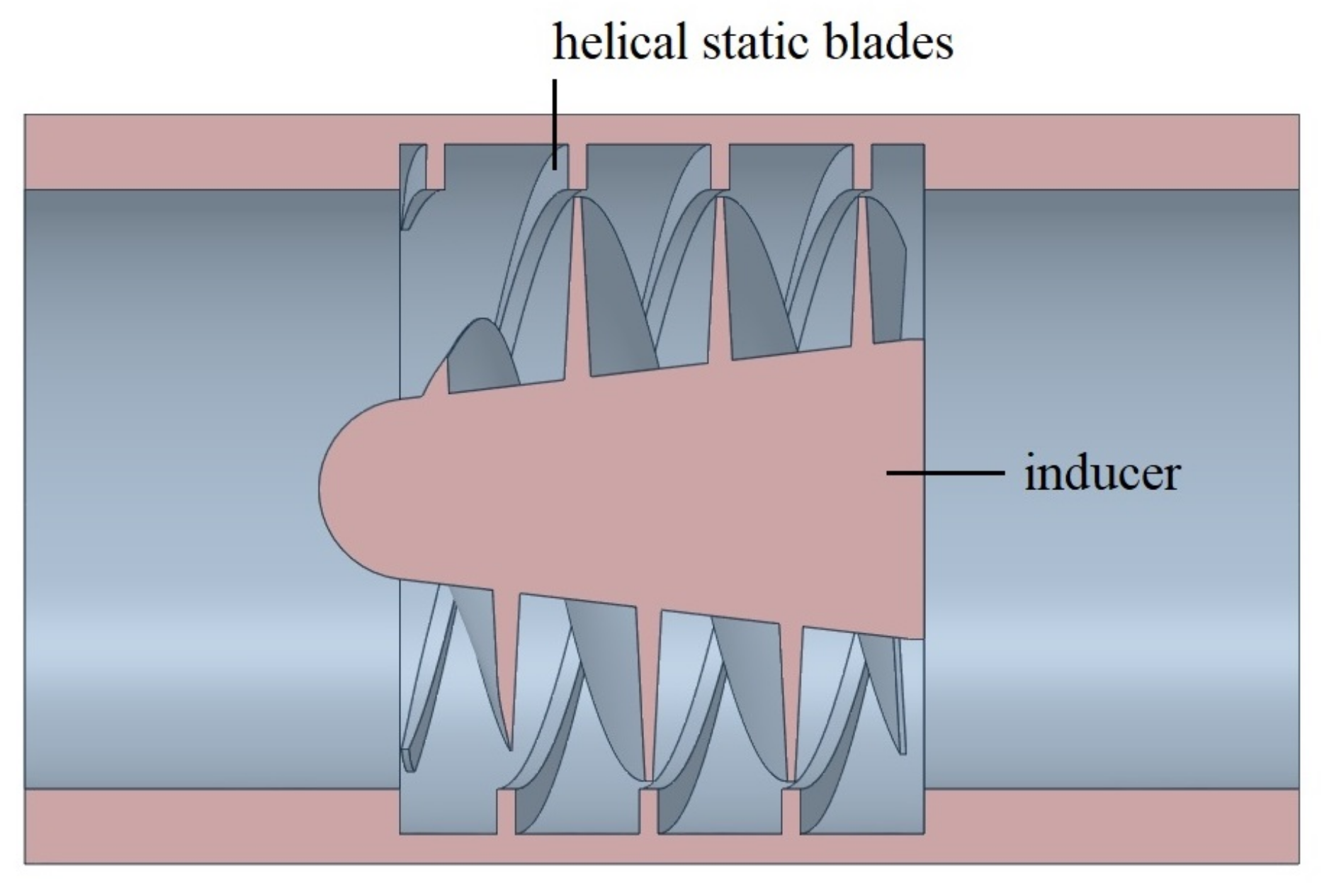
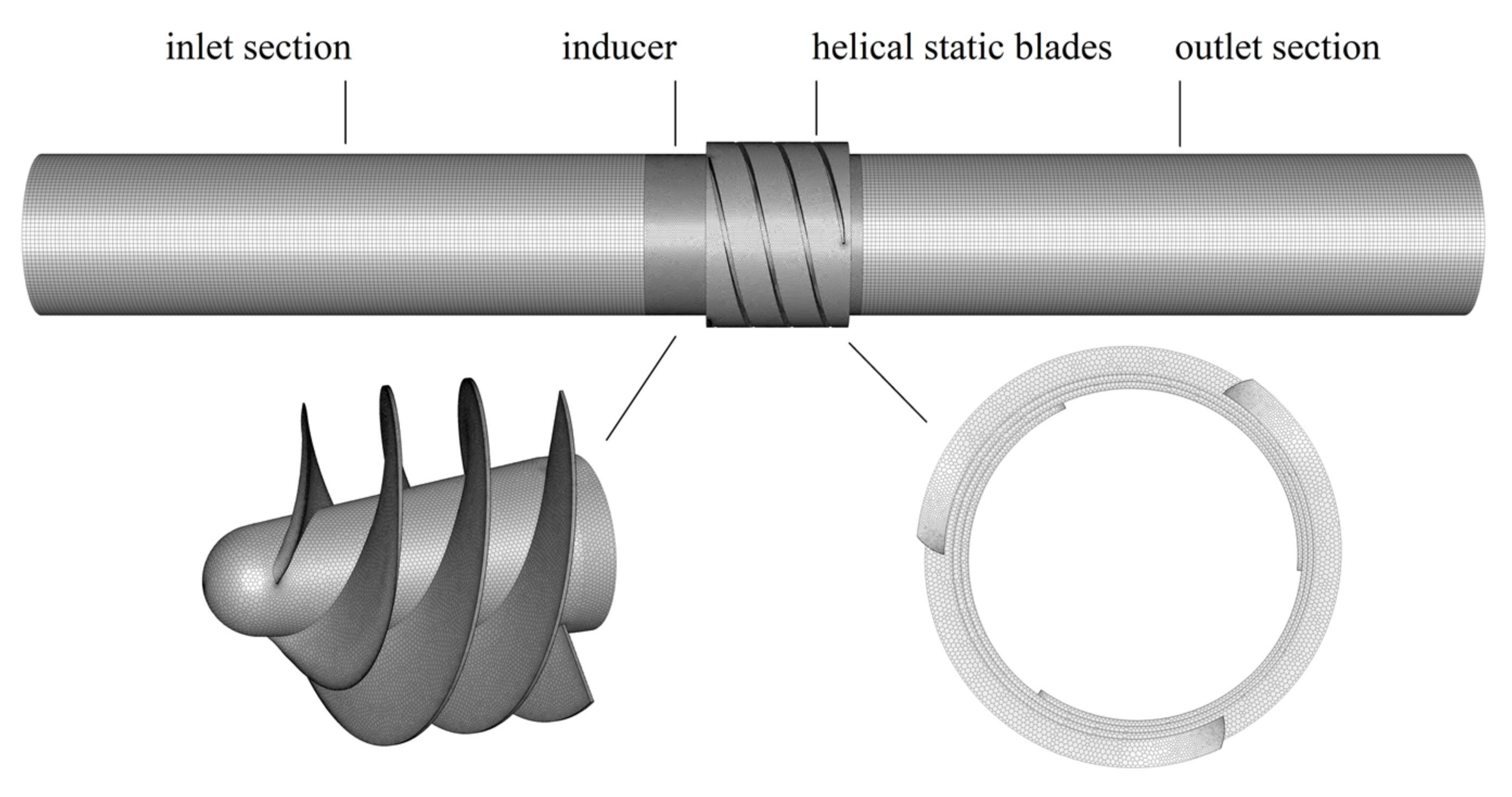
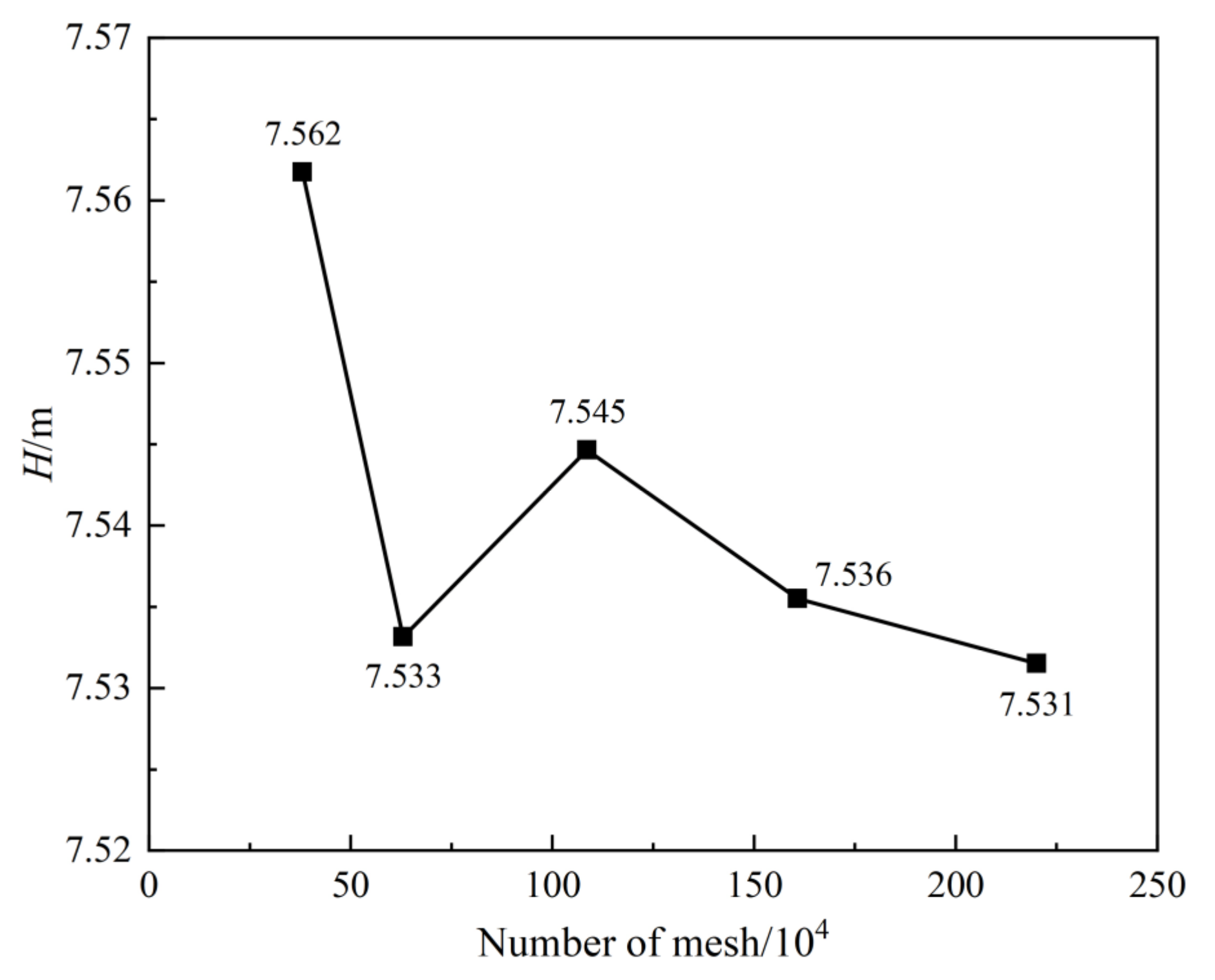


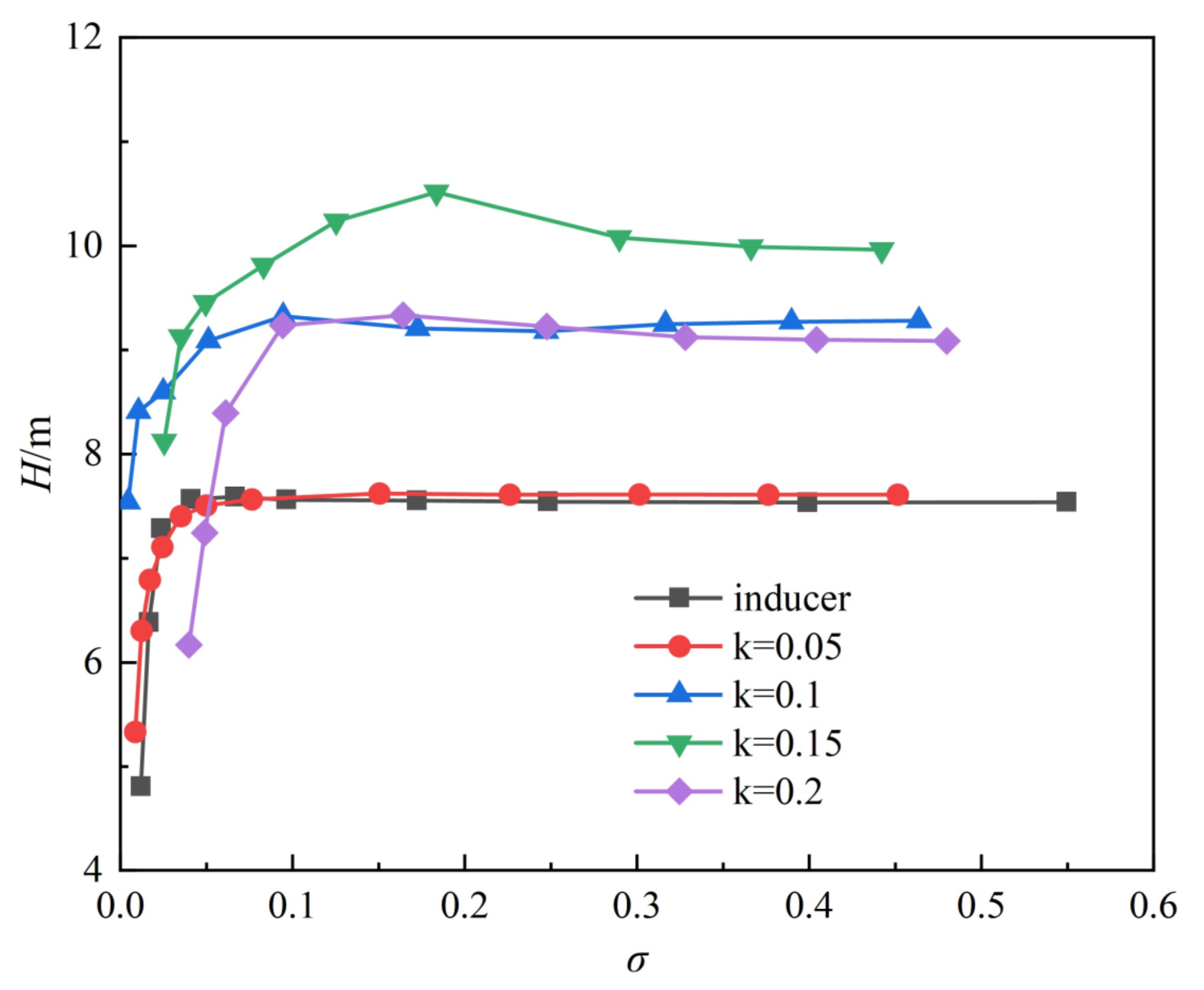
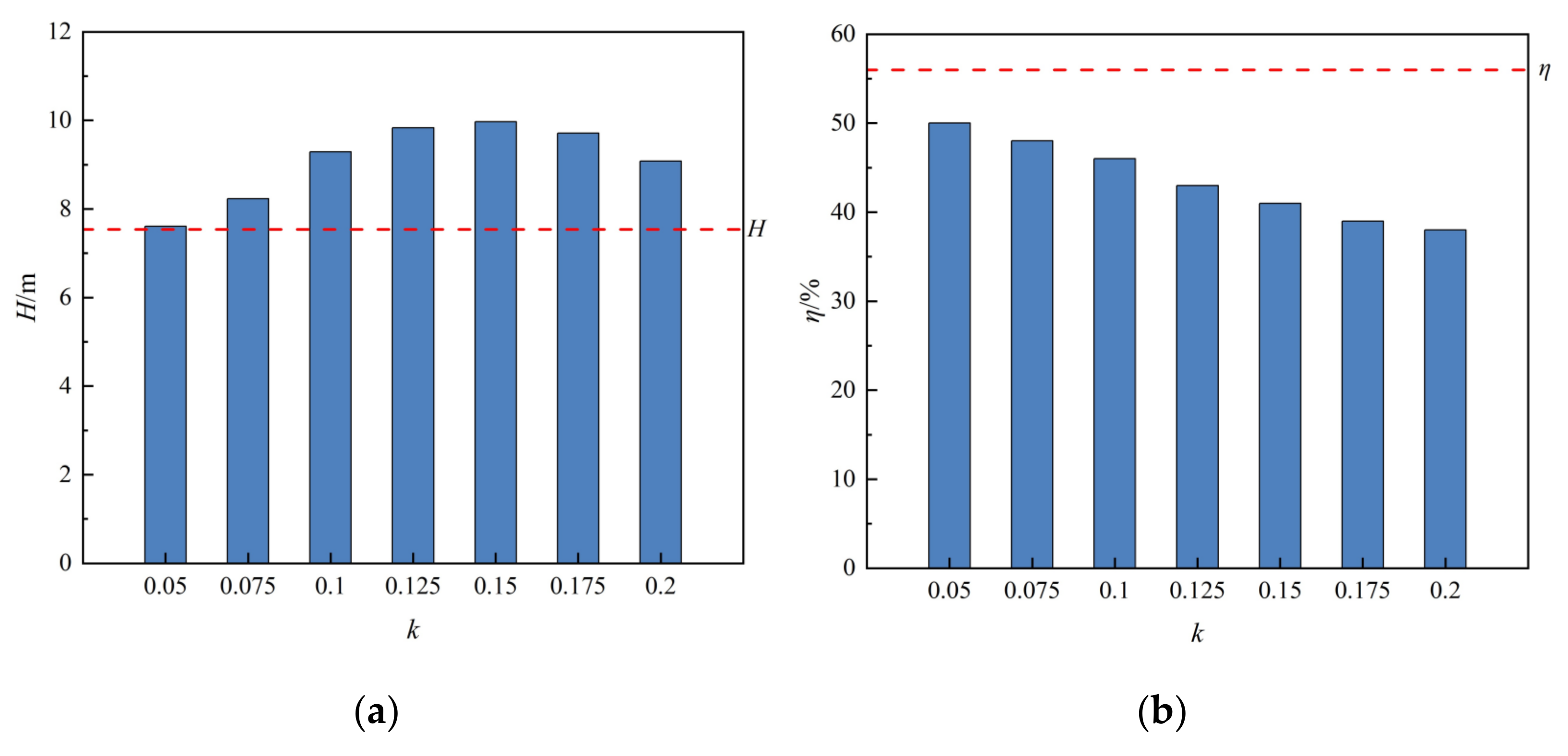
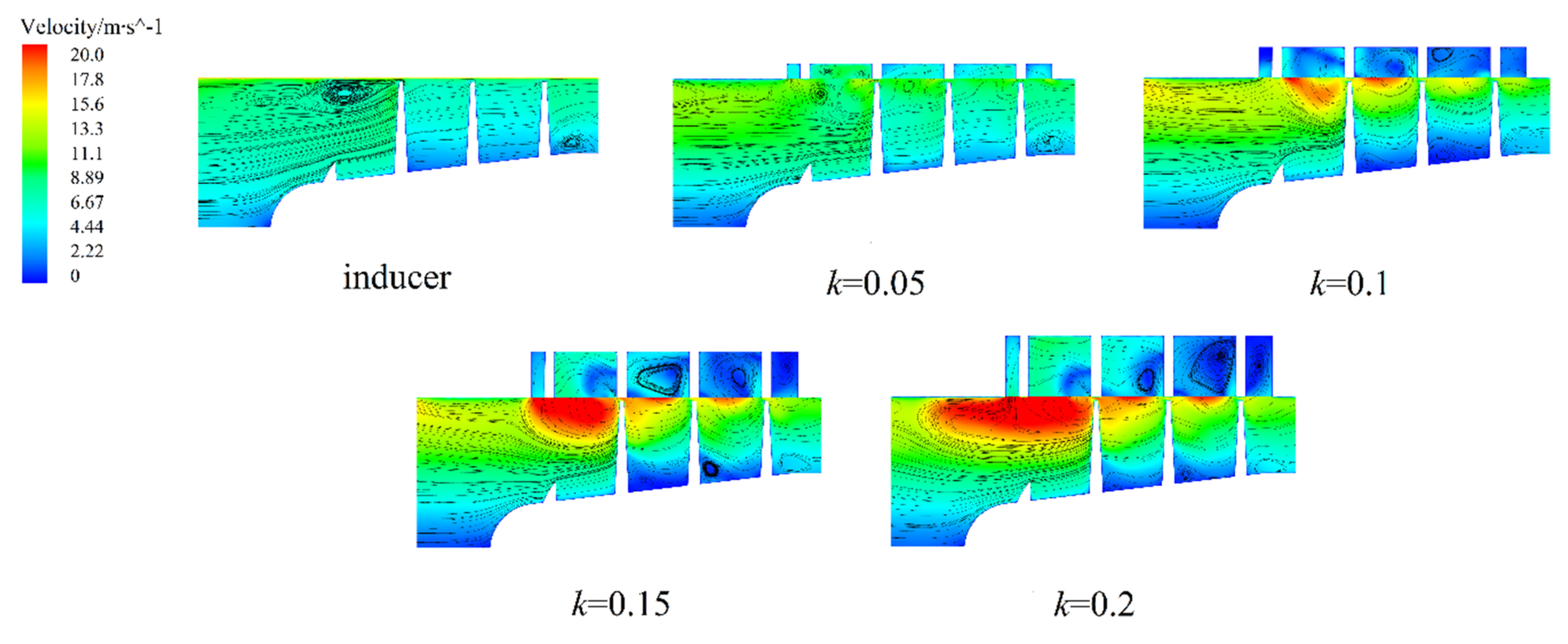



| Parameters | Number of Blades | Inlet Hub Diameter dh1/mm | Outlet Hub Diameter dh2/mm | Tip Diameter Dt/mm |
|---|---|---|---|---|
| Value | 3 | 24 | 40 | 78 |
| Scheme | k | Radial Height hr/mm |
|---|---|---|
| Scheme 1 | 0.05 | 4 |
| Scheme 2 | 0.075 | 6 |
| Scheme 3 | 0.1 | 8 |
| Scheme 4 | 0.125 | 10 |
| Scheme 5 | 0.15 | 12 |
| Scheme 6 | 0.175 | 14 |
| Scheme 7 | 0.2 | 16 |
Publisher’s Note: MDPI stays neutral with regard to jurisdictional claims in published maps and institutional affiliations. |
© 2022 by the authors. Licensee MDPI, Basel, Switzerland. This article is an open access article distributed under the terms and conditions of the Creative Commons Attribution (CC BY) license (https://creativecommons.org/licenses/by/4.0/).
Share and Cite
Bi, C.; Li, J. Effect of Radial Height of Helical Static Blade on the Cavitation Performance of Inducer. Appl. Sci. 2022, 12, 3897. https://doi.org/10.3390/app12083897
Bi C, Li J. Effect of Radial Height of Helical Static Blade on the Cavitation Performance of Inducer. Applied Sciences. 2022; 12(8):3897. https://doi.org/10.3390/app12083897
Chicago/Turabian StyleBi, Chenyu, and Jiawen Li. 2022. "Effect of Radial Height of Helical Static Blade on the Cavitation Performance of Inducer" Applied Sciences 12, no. 8: 3897. https://doi.org/10.3390/app12083897
APA StyleBi, C., & Li, J. (2022). Effect of Radial Height of Helical Static Blade on the Cavitation Performance of Inducer. Applied Sciences, 12(8), 3897. https://doi.org/10.3390/app12083897





